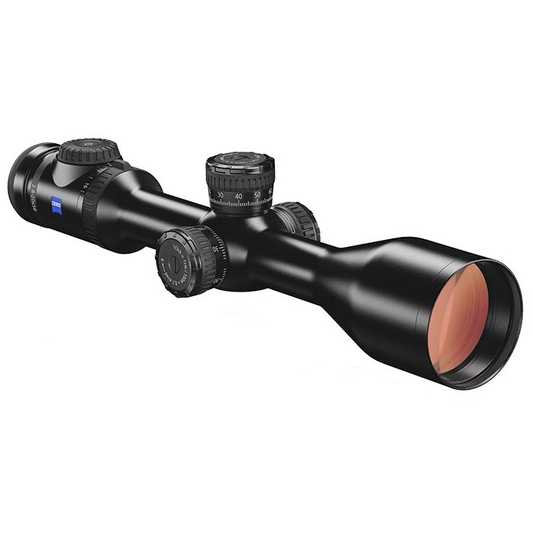

The Zeiss Victory V8 2.8-20x56mm is the epitome of high-performance optics, designed to elevate the hunting experience. With a magnification range from 2.8x to 20x, it provides versatility for both close-range precision and long-range accuracy. This riflescope, with its generous 56mm objective lens, delivers an unparalleled 92% light transmission. It results in bright, vivid images even in the twilight hours of dawn or dusk. The integration of SCHOTT fluoride glass and the proprietary T* Lens coatings by Zeiss ensures full-color fidelity and clarity, enhancing the user's visual experience under any condition.
Crafted for the most demanding environments, the Victory V8 features the innovative LotuTec coating that repels water and dirt, guaranteeing clear visibility in all weather conditions. Its #43 reticle, placed on the second focal plane, combined with the .33 MOA adjustment precision, offers shooters the confidence to make accurate shots over varied distances. The intelligent motion sensor technology in the illumination control automatically activates the reticle, streamlining the process for rapid target acquisition.
Long-range hunting, competitive shooting, and even predator hunts are transformed with the V8's advanced features. The ASV Extended Elevation Turret allows for intuitive and immediate adjustments, critical in dynamic shooting scenarios. With its robust construction and sleek black finish, the Zeiss Victory V8 2.8-20x56mm Riflescope 522131-9943-040 is not just a tool but an extension of the hunter's intent, ensuring every shot counts.
Zeiss Victory V8 2.8-20x56 Features
- OPTICAL EXCELLENCE: SCHOTT fluoride glass lenses with T* coating for maximum clarity and color fidelity.
- BRIGHT VIEW: 92% light transmission ensures vivid imagery in low-light conditions.
- PRECISE ADJUSTMENT: .33 MOA elevation adjustments for accurate long-range shooting.
- WEATHER RESISTANT: LotuTec coating for clear vision in all weather scenarios.
- VERSATILE MAGNIFICATION: Ranges from 2.8x to 20x, suitable for various hunting situations.
- SMART ILLUMINATION: Intelligent motion sensor for automatic reticle illumination.
- DURABLE DESIGN: Black finish and sturdy construction for enduring reliability.
- USER-FRIENDLY INTERFACE: Multi-function button for manual illumination control.
Zeiss Victory V8 2.8-20x56 Specifications
| Feature | Specification |
|---|---|
| Weight | 28.04 ounces |
| Length | 13.77 inches |
| Magnification Range | 2.8x - 20x |
| Objective Diameter | 56mm |
| Tube Size / Mount | 30mm |
| Turret Adjustment (Click Value) | .33 MOA |
| Elevation Turret Details | 210cm @ 100m |
| Windage Turret Details | 135cm @ 100m |
| Parallax Adjustment | 50m to infinity |
| Reticle Position | Second focal plane |
| Reticle Details | #43 |
| Field of View | 15.5m @ 100m (low) / 2.1m @ 100m (high) |
| Exit Pupil | 9.9mm (low) / 2.8mm (high) |
| Eye Relief | 92mm |
| Twilight Factor | 7.9 – 33 |
| Light Transmission | 92% |
| Illuminated Reticle | Yes |
| Finish | Black |
| Turret Rotation | Counter Clockwise (CCW) |
| UPC | 740035016422 |
| MPN | 522131-9943-040 |
Included In The Box
- Zeiss Victory V8 2.8-20x56mm Illum SFP #43 BDC/ASV Ext. Elev. Turret Riflescope
- Protective Lens Caps
- Lens Cleaning Cloth
- User Manual
- Warranty Information Card
You May Also Like
Here’s some of our most similar products people are buying. Click to discover trending style.







